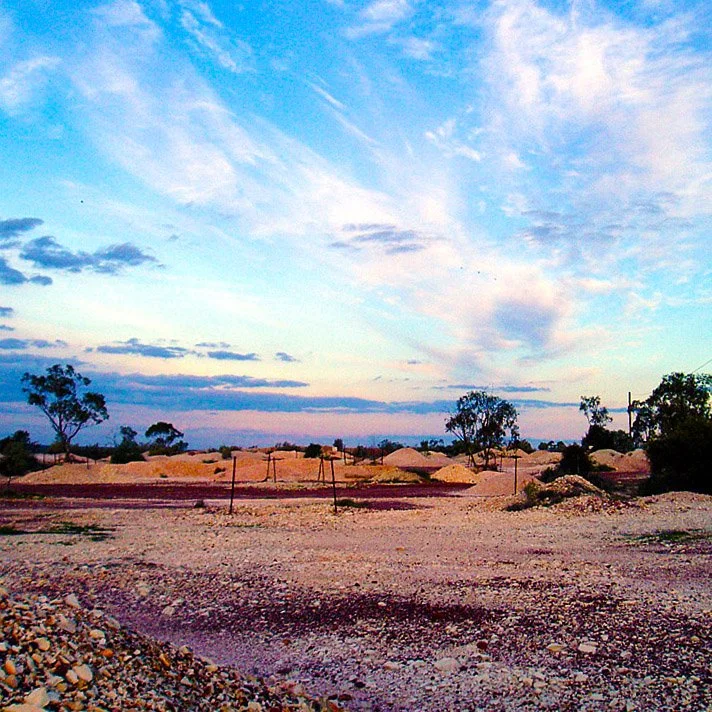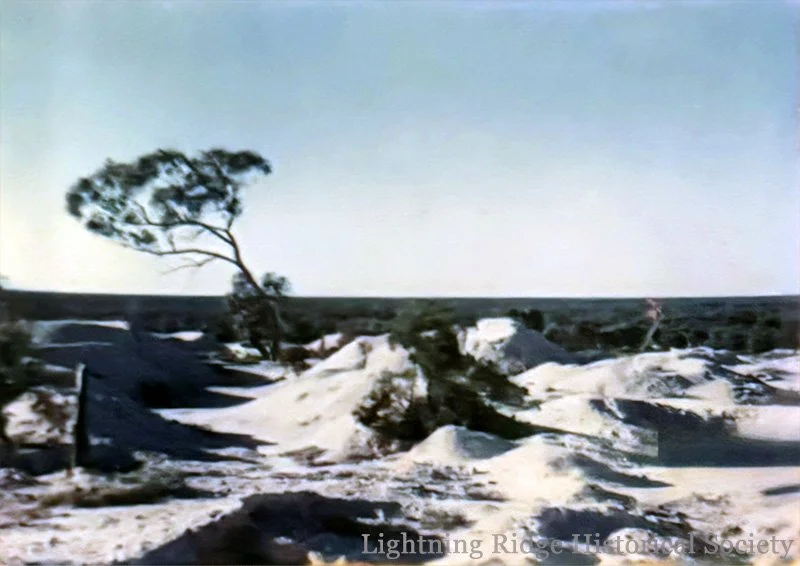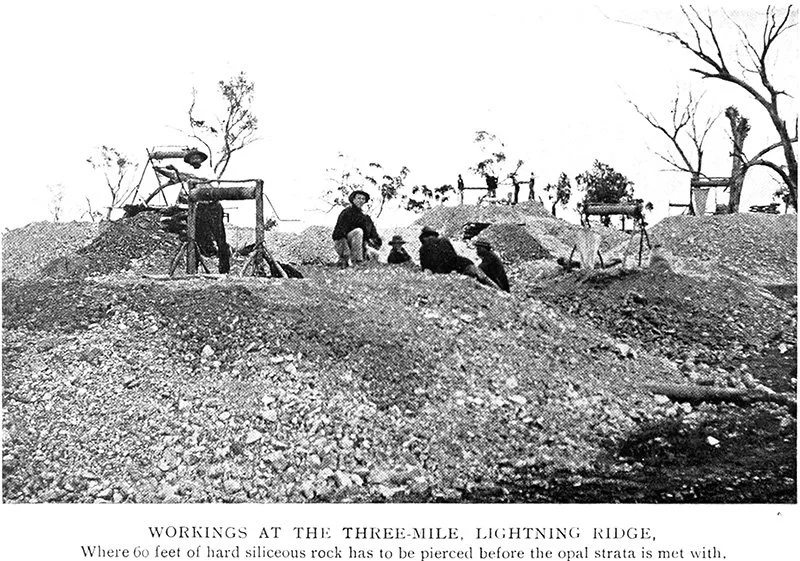The Three Mile
Photograph courtesy of Russell Gawthorpe.
The Three Mile is one of the most historically significant and productive opal fields at Lightning Ridge. Located roughly three miles northwest of Sim’s Hill along the main ridge, it was the site of the second major rush in the district, beginning in 1908. For much of the early 20th century, it was regarded as the richest opal producing field.
The field spans about 400 acres, comprising a number of subfields including the Deep Three Mile, The Gully, Lunatic Hill and Western Fall. Notable claims include P. & O. Jacks, Deadman’s, the Revolver claim, and the Leaning Tree.
The famous Leaning Tree claim in the 1960s. Photograph: Lightning Ridge Historical Society collection.
The field was mined at depths ranging from surface level to over 80 feet, with up to four levels worked. The second level, between 52 and 72 feet, was often the most productive, while some deeper levels produced seam opal that was known to craze. The opal bearing level varied in thickness from two to seven feet. The Three Mile ground was difficult, with broken levels and frequent faults, the chaotic geological structure likely correlated to the abundance of gem quality opal on the field.
Archie Gillespie and Darkie Anderson are recognised as first to find the field in 1908, with “Son” Bruce and Jacky Main igniting further interest in 1909.
“The opal from this area was greater than from the rest of the field.”
The Gully, running up toward the high ground, was productive across multiple levels, generally 33 feet and 60 feet, and was one of the most consistently worked areas. The Nettleton settlement was situated in the Three Mile Flat, adjacent to The Gully, in the area surrounding Fred Bodel’s hut. Fred Bodel worked at The Gully, and is understood to have encouraged interest in the area by showing off his finds.
By 1910, some 700 to 1,000 miners were working on the Three Mile fields. The main ridge was lined with windlasses and the skyline “looked like a trellis.”
Lunatic Hill, at the top of the ridge, was named after someone reportedly shouted “Only a bloody lunatic would go up there!” when miners began working high above The Gully in 1909. Lunatic Hill produced some of the best black opal on the field. Similar success occurred at Scott’s claim, where Harry Callanan teamed up with Jack Scott and went on to recover a fortune in opal. See: Lunatic Hill.
The western slope of the Three Mile ridge, known as Western Fall, produced excellent opal, with several levels worked between 2 and 40 feet. The best-known claim was held by Turner & Sons, but other productive claims included those of Paddy Kelly, Jimmy Steadman, Mat Watson, and David and Bruce McRae. Otto Marquet and Otto Schroder (the “Two Ottos”) worked the same claim for years, while prominent opal buyer Ernie Sherman sank his only shaft here. See also: “Water Fall”.
The Three Mile was home to dozens of well-known claims, some examples include:
P. & O. Jacks – named after Jack Wilding, a ship’s cook who had arrived on a P&O liner. This claim produced high grade stones. Herb Rowland and “Bill the Frenchman” later took over a nearby vacated claim and reportedly made £1,200.
Deadman’s – named for miner Jim Coleman, who died of a heart attack while filling a bucket with water.
The Revolver Claim – named after incident where Mrs. McNally drew a revolver on an opal mining solicitor who attempted to evict her sons, who were his two mining partners.
Leaning Tree – a famously successful claim with a slanted tree as a landmark.
Scotts – named after the Callanan and Scott partnership.
The field continued well into the mid-20th century. Open cut mining, puddling (both dry and wet), and specking remained viable into the 1960s and 70s, and many shafts and claims were reopened or reworked. By the 1960s the field had produced a recorded £910,000 worth of opal (over $20 million in 2025 dollars) — a mere percentage of the field’s total yield to date.
Article: Research by Russell Gawthorpe and Leisa Carney, edited by Russell Gawthorpe. LRHS research compiled by Len Cram and Barbara Moritz. Sources: Lightning Ridge: The Land of Black Opals, Ion L. Idriess, 1940, chapter XIV; The Lightning Ridge Book, Stuart Lloyd, 1967, pp. 57-60; Lightning Ridge - The Home of the Black Opal: Unique to the World, Gan Bruce, 1983, pp. 68-70; The Occurrence of Opal at Lightning Ridge and Grawin, with Geological Notes on County Finch, J. W Whiting & R. E. Relph, 1958, p. 10; Walgett Spectator, 24 November 1921, 1 December 1921, 28 October 1931; Discover Opals: Before and Beyond 2000 with Surface Indications, Stephen Aracic, 1996, p. 143.



